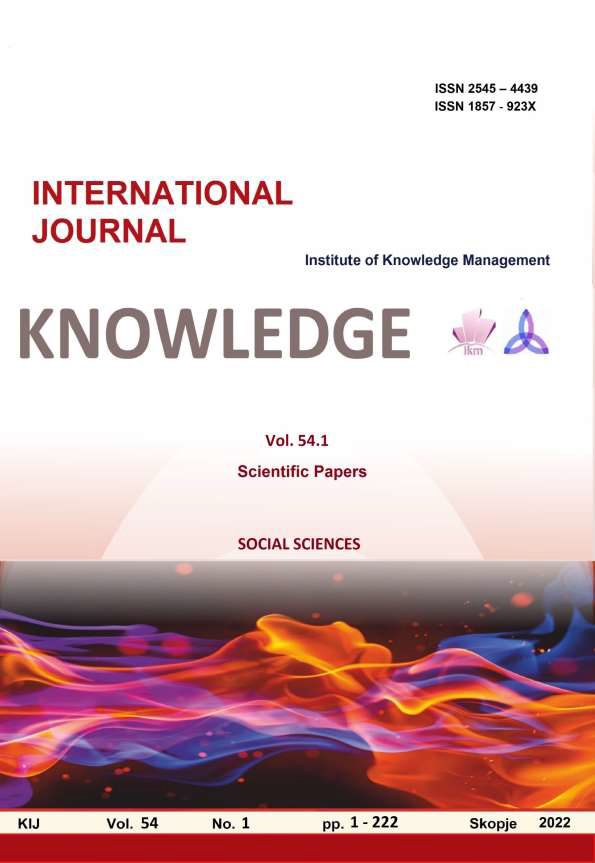THE IMPACT OF ARTIFICIAL INTELLIGENCE ON ECONOMIC THEORY: THE CASE OF THE PHILLIPS CURVE
Keywords:
Phillips curve, artificial intelligence, economic theoryAbstract
The fourth industrial revolution at the beginning of the twenty–first century was marked by the significant
development of new technologies. This development resulting in the transformation of the social and economic
system. As a consequence of that transformation, it is necessary to consider the impact of technology on social and
economic theories that study those systems. The aim of this paper is to consider the influence of artificial
intelligence on one of the important economic concepts – the Phillips curve. Artificial intelligence refers to the
development of software that enables machines to behave "intelligently". This means that AI uses algorithms to
perform autonomous actions. The significance of the application of AI is reflected in her accuracy, speed, and
practical applicability, because the results of the application of algorithms are more precise and based on innovative
sources of information. The increasing use of these technologies is causing tectonic social changes. After the Great
Depression of 1929, the problem of unemployment reached dramatic proportions, and at the same time it becomes
the main subject of macroeconomic analysis. With the Keynesian revolution, the concept of the Phillips curve as the
inverse relationship between the inflation rate and the unemployment rate have become one of the key instruments
in the economic policy decision–making process. In the 1970s economic growth slowed while inflation rose. The
Phillips curve loses its stability, while economic systems are hit by stagflation. The relationship between inflation
and unemployment has been redefined within monetarism: the inflation–unemployment trade–off is achieved only in
the long run at the level of the natural unemployment rate. New Keynesians added expectations about inflation to the
Phillips curve (hybrid New Keynesian Phillips curve). In that Phillips curve, the relationship between individuals
with adaptive and individuals with rational expectations is crucial. If the system is based on decisions made by AI
and on decisions made by humans, it is uncertain whether rational or behavioral choice will prevail. If there are only
rational agents in the system, then rational expectations dominate. The emergence of new technologies raised the
question of its impact on the labor market. There are usually two points of view: firstly, that the emergence of new
technologies leads to mass unemployment or secondly, that the emergence of new technologies will create new
professions and new fields of work. If there is complementarity of human and machine labour, this leads to an
increase in average wages. But, if AI dominates in the future data-driven society, policymakers should provide
protection for low– and middle–skilled workers with the aim of reducing inequality, encouraging growth and
preventing social difficulties.
References
Auerswald, P. (2017). The Code Economy: A Forty-Thousand-Year History. NewYork: Oxford University Press.
Dixon, M. F., & Halperin, I. (2019). The Four Horsemen of Machine Learning in Finance. Available at SSRN 3453564.
Executive Office of the President of the United States (2016). Artificial Intelligence, Automation, and the Economy. Washington.
Gali, J., & Gertle, M. (1999). Inflation Dynamics: A Structural Ecnomometric Analysis. Journal of Monetary Economics, 44, 195–222.
Goolsbee, A. (2018). Public Policy in An AI Economy. ResearchWorking Paper 24653, Cambridge, MA: National Bureau Of Economic.
Kahyaoglu, H. (2021). The Impact of Artificial Intelligence on Central Banking and Monetary Policies. In S. B., Kahyaoglu (ed.) The Impact of Artificial Intelligence on Governance, Economics and Finance (vol I, pp. 83–98). Singapore: Springer Nature Singapore.
Keynes, J. M. (1926). The End of Laissez-faire. London: The Hogarth Press
Kosanović, N. (2022). Veštačka inteligencija: kontrola podataka, tržište i demokratija. Ekonomske ideje i praksa, 45, 31-45.
Kosanović, N., Božović, A., & Kosanović, N. (2021). Decentralizovani mrežni model uprave i blokčejn tehnologija, u Zec, M., Arsić, M., Radonjić, O. (ured.), Ekonomska politika u Srbiji i svetu u 2021 – u susret globalnim šokovima i rastućoj neizvesnosti (str. 143-154). Beograd: Ekonomski fakultet Univerziteta u Beogradu.
Kuhn, M., & Johnson, K. (2013). Applied predictive modeling (Vol. 26, p. 13). New York: Springer.
Lucas, R. (1976). Econometric Policy Evaluation: A Critique. In K. Brunner & Meltzer, A. (eds.). The Phillips Curve and Labor Markets (vol 1, pp. 19–46). New York: American Elsevier.
Marwala, T., & Hurwitz, E. (2017). Artificial Intelligence and Economic Theory: Skynet in the Market. Cham: Springer International Publishing AG
Moloi, T., & Marwala, T. (2020). Artificial Intelligence in Economics and Finance Theories. Cham: Springer Nature Switzerland AG.
Parkes, D. C., & Wellman, M. P. (2015). Economic Reasoning and Artificial Intelligence. Science, 349(6245), 267–272.
Phillips, A.W. (1958). The Relation Between Unemployment and the Rate of Change of Money Wage Rates in the United Kingdom, 1861–1957. Economica, 25, 283-299.
Romer, D. (2012). Advanced Macroeconomics. 4th ed., New York: McGraw-Hill.
Screpanti, E., Zamagni, S. (2005). An Outline of the History of Economic Thought. 2nd ed., New York: Oxford University Press.
Van de Gevel, A. J., & Noussair, C. N. (2013). The Nexus Between Artificial Intelligence and Economics. Berlin: Springer.
Yalçınkaya, T. (2021). New Technologies and Economic Policies in the Global System. In S. B., Kahyaoglu (ed.) The Impact of Artificial Intelligence on Governance, Economics and Finance (vol I, pp. 139–163). Singapore: Springer Nature Singapore.
Zarić, S., & Božović, A. (2021). The Impact of Digitization on Economic Growth and How To Measure It. KNOWLEDGE – International Journal, 48(1), 17–23.





